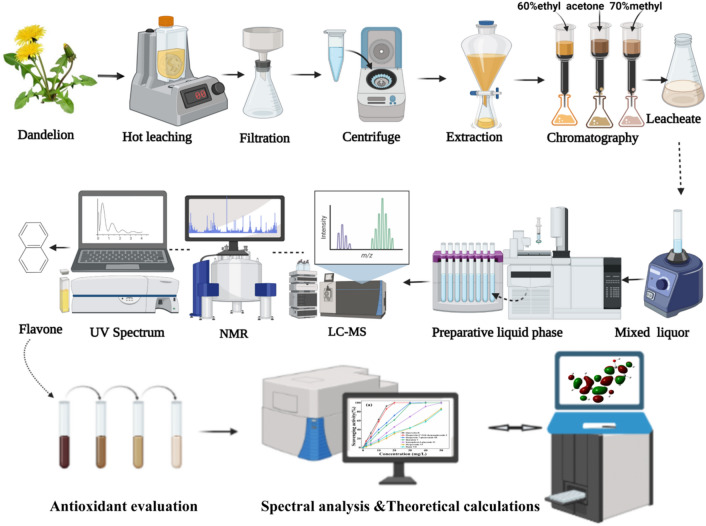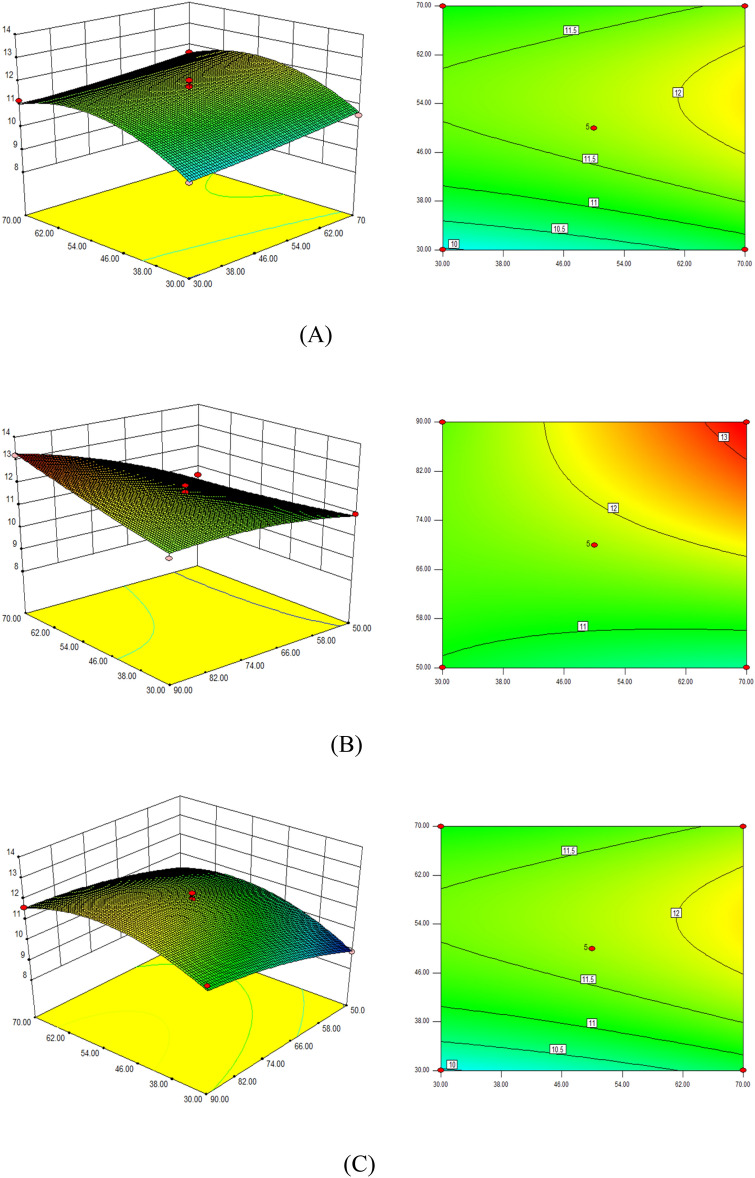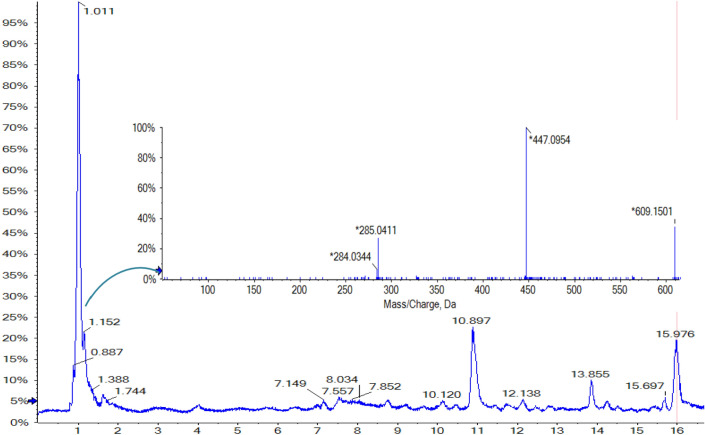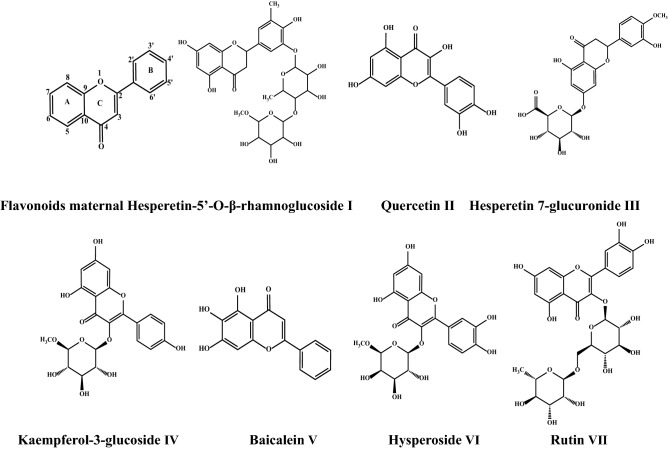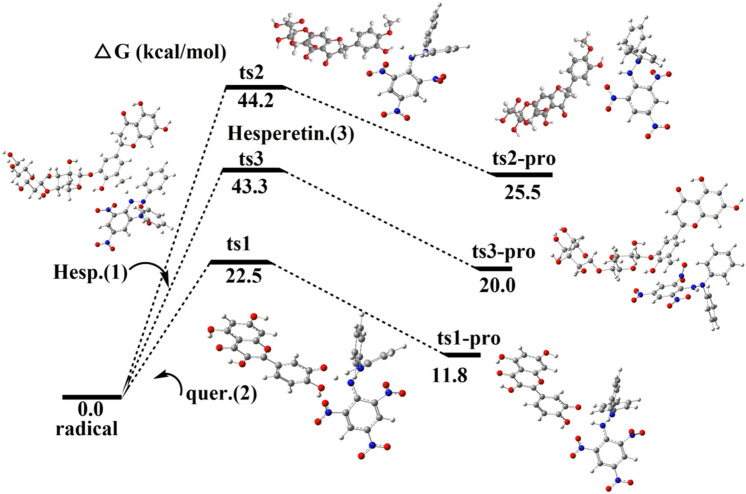Abstract
Due to the interest in the potential pharmacological application of dandelion, the chemical constituents and activities of Taraxacum mongolicum Hand.-Mazz were studied. Box–Behnken response surface methodology was employed to optimize the protocol for extraction of flavonoid from dandelion. The molecular structures of different flavonoid compounds were acquired and analyzed by liquid chromatography-mass spectrometry (LC–MS) and nuclear magnetic resonance (NMR) spectroscopy. Several major flavonoid compounds were isolated and purified, namely, hesperetin-5′-O-β-rhamnoglucoside, hesperetin-7-glucuronide, kaempferol-3-glucoside, baicalein, hyperseroside, which were extracted for the first time from dandelion. Hesperetin-5′-O-β-rhamnoglucoside was identified as a new type of flavonoid that had never reported in the literature. This new flavonoid has outstanding antioxidant activity, as shown by its IC50 value (8.72 mg/L) for scavenging DPPH free radicals. The determination of the structure-related antioxidant activities could be interpreted based on DFT calculations. As such, we have not only illustrated the rich flavonoid contents in Taraxacum mongolicum Hand.-Mazz, but also revealed new types of flavonoid compounds in dandelion in terms of structure and antioxidant properties.
Subject terms: Biochemistry, Drug discovery, Molecular biology, Plant sciences
Introduction
Dandelion Taraxacum mongolicum Hand.-Mazz (T. mongolicum Hand.-Mazz) is a perennial herb which can be used as both medicine and food1. It belongs to compositae, alias Huanghuading, or popoding as indicated in the second edition of the Chinese Pharmacopoeia2. Nowadays the application of dandelion is increasing, and the research on its chemical composition and pharmacological action is gaining more attention3. Generally, dandelion contains a variety of biologically active components, including flavonoids, triterpenes, sesquiterpenes, phenolic acids, sterols and coumarins, with high edible and medicinal value4. Particularly, dandelion has antibacterial, anti-inflammatory, antioxidant, hepatoprotective and anti-tumor pharmacological activities5. Flavonoid is one class of the main bio-active components in dandelion, which is closely associated with the pharmacological effects of dandelion. For example, the medicinal effects of dandelion such as anti-cancer, anti-aging, liver-protecting, cholagogic and bacteriostasis properties, are either directly or indirectly related to the activities of flavonoids6.
In recent years, many studies explored the pharmacological effects and clinical application of dandelion crude preparations, while it is necessary to investigate the pharmacological effects of single chemical compounds such as flavonoids from dandelion. Yanghee et al. conducted experimental studies on the medicinal effect of aqueous extract of dandelion root of T. mongolicum7. Yuldashev et al. isolated flavonoids including luteolin, quercetin and their derivatives from the roots of medicinal dandelion (T. officinale Wigg.)8. Shi et al. obtained artemisinin and quercetin from T. Mongolian dandelion, and identified two new flavonoids, namely, isoetin-7-O-β-d-glucopyr-anosyl-2′-0-a-l-arabinopyranoside, isoetin-7-0-β-d-gluco9. In general, flavonoids stem from secondary metabolic components in plants, which are very important in phytochemistry10,11. In terms of chemical structure, there are different flavonoid compounds in which aromatic ring A fuses with pyranone ring C and then connects with another aromatic ring B, and have the basic skeleton characteristics of C6-C3-C6. There are many connecting sites between basic skeleton C ring and B ring, and A ring and B ring often have substituents such as hydroxyl, methoxy, methyl and isopenty, resulting in many different derivatives and active functions12. Figure 1 illustrates the flavonoid parent structures, while flavonoids in plants exist mostly in the form of glycosides, that is, hydroxyl groups connected with sugar units and two aromatic rings (A and B). Many studies have proved that the medicinal value of dandelion has a close relationship with the antioxidant activity of dandelion flavonoid13,14. However, dandelion flavonoid compounds are complex, and there is a lack of comprehensive analysis of dandelion flavonoids in terms of structure and antioxidant activity. Therefore, it is of great interest to explore the different forms and antioxidant activities of dandelion flavonoid compounds and analyze the corresponding structure–activity relationship.
Figure 1.
Main parent structures of flavonoids.
In this work, we conducted the study on the extraction and identification of new flavonoid compounds in dandelion Taraxacum mongolicum Hand.-Mazz. and evaluated their antioxidant activities. Figure 2 illustrates schematically the experimental procedure. The extraction of the main flavonoid compounds were optimized from Taraxacum mongolicum Hand.-Mazz by using response surface methodology. Then, these compounds were purified by preparative high performance liquid chromatography (PHPLC) and analyzed using liquid chromatography-mass spectrometry (LC–MS) and nuclear magnetic resonance (NMR) spectroscopy. The compound structures were determined based on experimental data and also confirmed by theoretical calculations based on density function theory (DFT). The antioxidant activities of the extracted flavonoid compounds were evaluated based on the assessment of the ability of scavenging DPPH free radicals. The structure–activity relationship of the interested flavonoid compounds was therein explored and discussed.
Figure 2.
Schematic diagram demonstrating our research on extraction, purification, structural identification and antioxidant evaluation of the flavonoid compounds from Taraxacum mongolicum Hand.-Mazz.
Results
Optimization of extraction conditions
All experiments were carried out through Design-Expert design response surface optimization experimental scheme. According to the response surface model, the optimum extraction conditions were obtained as follows: extraction time 70 min, liquid-material ratio 52.56:1 (mL/g), extraction temperature 80 °C (the parameters for the response surface optimization are provided in Table S1 and Table S2), and the theoretical yield of total flavonoids of dandelion was 13.31% according to the method reported previously15. Considering the simple and practical operation, the optimum extraction process of total flavonoids from dandelion was 70 min, the ratio of liquid to material was 53:1 (mL/g), and the extraction temperature was 80 °C. Each experiment was repeated at least three times under the same conditions. To be noted, the single factor experiments were initially conducted to investigate the effect of related factors on the studied outcome (Fig. S1). As a result, the average yield of total flavonoids of dandelion was 14.12%, and the relative error with the theoretical value (13.31%) was 5.74%, and the prediction ability and feasibility of the model meets the actual expectation (Fig. 3). The quadratic polynomial equation was used for the multiple regression fitting: Y = 11.74 + 0.33A + 0.49B + 0.85C − 0.037AB + 0.59AC − 0.21BC + 0.071A2 − 0.98B2 − 0.29C2.
Figure 3.
Extraction response surfaces with changes of variable factors: (A) Extraction result depending on time and liquid to material ratio, with fixed temperature (80 °C). (B) Extraction result depending on time and temperature, with fixed liquid to material ratio (52.56:1 (mL/g)). (C) Extraction result depending on liquid to material ratio and temperaturem, with fixed time (70 min).
Tables S1 and S2 list the parameters for the fitting. A, B, C, AC, B2 had a significant effect on the total flavonoids yield (P < 0.01), while AB, BC, A2, C2 had no significant effect on the total flavonoids yield (P > 0.05).
Identification of new flavonoid compounds
In our study, seven main flavonoid compounds were extracted and purified from dandelion, which were then identified as hesperetin-5′-O-β-rhamnoglucoside (Compound I), quercetin (Compound II), hesperetin-7-glucuronide (Compound III), kaempferol-3-glucoside (Compound IV), baicalein (Compound V), hyperseroside (Compound VI), and rutin (Compund VII) (see details in Figs. S2–S18 for the experimental evidence). Among them, one new type of flavonoid was for the first time identified, namely, hesperetin-5′-O-β-rhamnoglucoside (Compound I), as it had never been reported in the literature. Figure 4 shows the total ion chromatogram and MS spectrum of the new Compound I. The peak time of Compound I is 1.011 min. The liquid chromatography mass spectrum exhibited molecular ion ratio m/z calculated for C28H34O15 (610.56 ([M−H]–: 609.15), m/z 447.1, 285.0 (base peak)). It was determined that the compound was a flavonoid according to its physicochemical properties and ultraviolet spectrum signal.
Figure 4.
LC–MS peak pattern and corresponding LC-MS2 M/Z pattern.
The structures of the extracted flavonoid compounds were determined by NMR. Figure 5 shows the 1D hydrogen spectrum and the 2D HSQC spectrum for Compound I. The singlet peaks at 12.03 ppm and 9.11 ppm stand for two protons from phenolic hydroxyl. The multiplet at 6.94–6.11 ppm for five protons form an aromatic ring and yet another multiplet at 5.52–4.46 ppm accounting for thirteen protons from cyclic –CH (glycone ring) were also observed. The singlet peaks at 3.78–3.64 ppm represent the three protons form –OCH3 group and a multiplet at 3.66–2.77 for alicyclic hydroxyl group, and a doublet at 2.29 ppm for two protons of –CH2OH group attached to glycone ring and the singlet representing three protons at 1.15–1.05 ppm for –CH3 were also found. The 13C NMR spectrum showed carbon signals at (HSQC, 125 MHz, δ ppm): 145.93, 144.24,131.81, 117.80, 114.07, 111.90, 103.29, 100.35 and 96.22 ppm represented romatic carbon atoms. The peaks at 87.32, 82.42, 78.39, 73.00, 71.75, and 70.11 were assigned for alicyclic carbons. The two carbons from CH2OH roup and a methyl group attached to glycone ring were represented at 28.36 and 18.02 ppm respectively. The oxymethine carbon and aliphatic thylene carbons were represented at 74.11 and 32.51 ppm respectively. The methoxy carbon was represented at 49.33 ppm. It was determined as hesperetin-5′-O-β-rhamnoglucoside.
Figure 5.
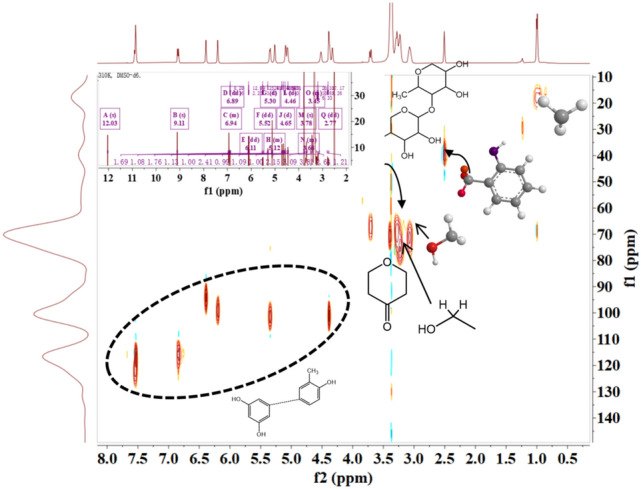
1H spectra and 13C HSQC NMR spectra of the new Compound I.
Furthermore, the structure of the new compound was confirmed by using DFT computation with b3lyp/6-311 g (d, p). For determination of the optimal structure of Compound I, 1H and 13C data were calculated using the DFT/GIAO method through the Gauss 09 program using b3lyp/6-311+g (2d, p) (Table 1). The chemical shift values given by DFT/B3LYP are very close to the experimental data, further verifying the determination of the molecular structure of Compound I.
Table 1.
Experimental and calculated 1H and 13C NMR data of new compound.
| Position | δH (exp.) | δH (cal.) | δC (exp.) | δC (cal.) |
|---|---|---|---|---|
| 2 | 4.49 | 4.39 | 78.39 | 78.03 |
| 3 | 6.94 | 7.28 | 45.37 | 43.83 |
| 4 | – | – | 196.44 | |
| 5 | 12.03 (s, H, –OH) | 12.06 | 164 | 166.64 |
| 6 | 6.19 (d, J = 1.9HZ, 1H) | 6.14 | 76.49 | 97.03 |
| 7 | 9.11(s, 2H) | 9.23 | 160.09 | 166.32 |
| 8 | 5.3 (d, J = 2.0HZ, 1H) | 5.26 | 96.20 | 97.04 |
| 9 | – | – | 161.66 | 165.44 |
| 10 | – | – | 103.29 | 103.76 |
| 1′ | – | – | 131.81 | 131.74 |
| 2′ | 6.89 (d, J = 2.148, 1H) | 6.75 | 127.80 | 124.6 |
| 3′ | 3.85 (s, 3H) | 3.73 | 131.22 (–CH3) | 129.86 |
| 4′ | 9.26 (s, –OH) | 145.93 (B-cyclic phenol) | 145.24 | |
| 5′ | – | – | 144.24 | 144.09 |
| 6′ | 6.11 (dd, J = 8.6, 2.0 Hz) | 111.90 | – | |
| 1″ | 7.47 | 7.28 | 100.35 | – |
| 2″ | 3.31 | 3.12 | 71.75 | 72.90 |
| 3″ | 1.65 | 1.42 | 70.11 | 70.54 |
| 4″ | – | – | 87.32 | 87.44 |
| 5″ | 1.29 (d, 3H) | 1.39 | 73.00 (–CH3) | 72.92 |
| 1‴ | 4.46 (dd, 1H) | 4.39 | 114.07 (C=O) | 114.63 |
| 2‴ | 3.54 (dd, 1H) | 3.56 | 76.98 (C–OH) | 75.03 |
| 3‴ | 4.6 (d, 1H) | 4.56 | 76.20 (C–OH) | 76.54 |
| 4‴ | 4.84 (d, 1H) | 4.93 | 69.50 (C–OH) | 67.78 |
| 5‴ | 3.85–4.03 (m, 3H) | 3.73–4.1 | 82.42 (–OCH3) | 82.03 |
The new flavonoid compound (I) is a white powdery substance, which can be dissolved in methanol and acetone. It was thus determined as hesperetin-5′-O-β-rham-noglucoside, (2-[3-[3, 4-dihydroxy-6-methyl-5-[3,4,5-trihydroxy-6-(hydroxymethyl) oxan-2-yl] oxyoxan-2-yl]oxy-4-h-ydroxy-5-methylph-enyl]-5,7-dihydroxy-2,3-di-hydrochromen-4-one) (Fig. 6).
Figure 6.
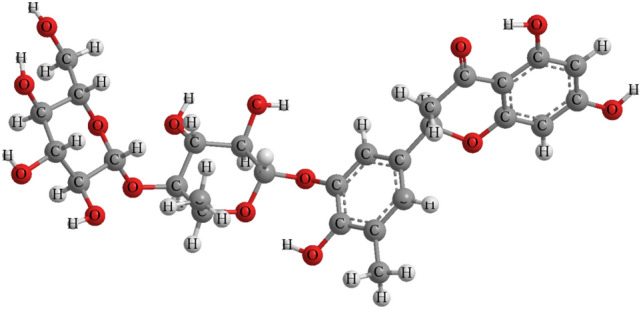
The structure of the new flavonoid compound (Compound I), hesperetin-5′-O-β-rhamnoglucoside.
Assessment of antioxidant activity
The antioxidant activities of the flavonoid compounds were assessed through the DPPH radical scavenging assay. DPPH is stable and easy to handle, which is often used to evaluate the activity of free radicals in scavenging antioxidants16. Figure 7 shows the change of absorption in the reaction process of the new component oxidant reactive with DPPH. The absorbance at 517 nm decreased with the increase of the concentration, showing the scavenging efficiency of the new compound.
Figure 7.

UV–Vis spectra of hesperetin-5′-O-β-rhamnoglucoside-DPPH· complex with oxidant concentration.
For the comparison of antioxidant capacity, IC50 was measured which is the concentration of half inhibition rate, that is, the concentration of scavenger when the free radical scavenging rate is 50%. The smaller the IC50 value is, the stronger is the scavenging effect or antioxidant capacity17,18. Figure 8 shows the results that the IC50 of the seven flavonoids in the sequence: quercetin (8.07 ± 0.67 mg/L) < hesperetin-5′-O-β-rhamnoglucoside (8.72 ± 0.88 mg/L) < kaempferol-3-glucuronide (13.49 ± 1.02 mg/L) < baicalein (15.5 ± 0.98 mg/L) < hesperetin-7-glucuronide (22.1 ± 0.76 mg/L) < hysperoside (31.39 ± 0.65 mg/L) < rutin (31.54 ± 0.79 mg/L) (Fig. S19; Table S3).
Figure 8.
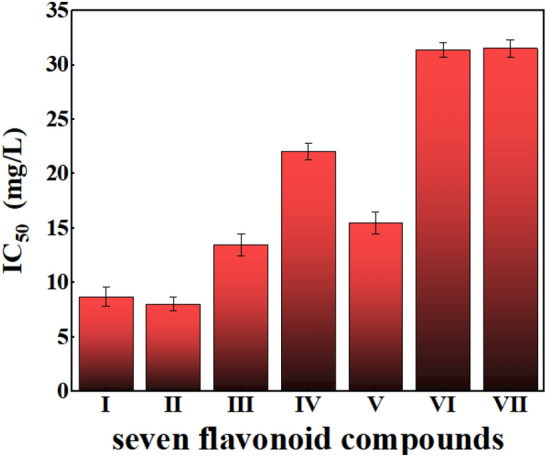
Comparison of the IC50 value of the new flavonoid (Compound I) with other extracted flavonoid compounds. All the measurements were made in triplicate, and the IC50 values are shown as the mean ± standard deviation in the plot.
Discussion
Relationship between structure and antioxidant capacity
The molecular structures of seven flavonoids are shown in Fig. 9. The activity of phenolic hydroxyl group in ring A is the weakest, while that in ring B is the highest. The ortho-disubstituted group in ring B is the necessary antioxidant group of flavonoids, especially when it is substituted by phenolic hydroxyl group19, and the antioxidant activity of 3-OH substitution in C ring is particularly important, among which the glycosylation of 3-OH in C ring is unfavorable, and the stronger the glycosylation degree is, the worse is the antioxidant activity. Therefore, the antioxidant activity is in the order as follows: quercetin > hesperetin-5′-O-β-rhamnoglucoside > hesperetin7-glucuronid, as the steric hindrance of large glycoside group plays a major role in shielding or hindering 3, 4-OH of B ring, resulting in its antioxidant activity reduction20. Catherine et al.21 also showed that 3-OH of C ring is very important because the hydroxyl group at C-3 position can be isomerized with the double bond at C-2 and 3 position to form a diketone form, producing a highly active CH group, and the unsaturated C ring extends the conjugate system of A ring and B ring, which makes the phenoxy radical more stable and enhances its antioxidant activity. Chun et al.22 showed that quercetin and myricetin have strong antioxidant activity due to with this structure.
Figure 9.
Structures of the extracted flavonoid compounds.
The experimental results showed that C-ring 3-OH glycosides reduced the antioxidant activity of flavonoids in scavenging DPPH free radicals. The more the number of substituted glycosides, the weaker the antioxidant activity, so the antioxidant activity of monoglycosides substituted flavonoids is better than that of diglycosides. As a result, the antioxidant activity is in the order: kaempferol-3-glycoside > hesperidin > rutin. Furthermore, It was found that the position of phenolic hydroxy group had more influence on the difference of antioxidant activity than the number of phenolic hydroxyl group. The existence of B ring phenolic hydroxyl group greatly improved the antioxidant activity, and the addition of B ring glycoside substituent has a positive effect on antioxidant activity23,24, so the antioxidant activity of glycoside substitution of C cyclic hydroxyl group would be unfavorable in the antioxidant capacity. Therefore, the antioxidant activity of baicalein is larger than that of kaempferol-3-glycoside.
Moreover, frontline orbital correlation coefficients can be used to characterize molecular antioxidant activity in quantum chemistry calculations25,26. According to molecular orbital theory, frontier orbitals include the highest occupied orbital and the lowest empty orbital, which are closely related to the reactivity of molecules. The highest occupied orbital energy (HOMO) characterizes the electron-giving ability of molecules, that is, the larger the HOMO, the stronger the electron-giving ability of molecules. The lowest empty orbital energy (LOMO) characterizes the ability of molecules to accept electrons, that is, the smaller the LOMO, the stronger the ability of molecules to accept electrons27,28. The frontline orbital energy level difference Δ E (Δ E = LUMO–HOMO) characterizes the energy required by molecules from ground state to excited state. The smaller the energy level difference is, the easier is the transition of electrons, so the stronger is the reactivity of molecules29. The frontier orbital energy levels of three difference molecules with strongest oxidation resistance were calculated. According to the data in Table 2, the HOMO energy level (− 5.738656 eV) of hesperetin7-glucuronide is higher than that of the other two compounds, and the electrons in this orbital are the most unstable and easy to lose. From the point of view of ΔE = (LUMO–HOMO), the molecular energy range is in the order of ΔE (hesperetin7-glucuronide) > ΔE (hesperetin-5′-O-β-rhamnoglucoside) > ΔE (quercetin). The calculated results are in good agreement with the experimental results (Table S3). The results show that the frontier molecular orbital energy level difference can be used as a reliable theoretical parameter to predict the free radical scavenging activity of flavonoids in the same type of molecules30.
Table 2.
The energy of HOMO, LUMO and ΔE = (LUMO–HOMO) of the four flavonoid compounds(eV).
| Energy level | Hesperetin-5′-O-β-rhamnoglucoside | Quercetin | Hesperetin 7-glucuronide |
|---|---|---|---|
| E(LUMO) [eV] | − 2.139008 | − 2.133296 | − 2.188512 |
| E(HOMO) [eV] | − 5.803936 | − 5.738656 | − 6.084368 |
| ΔE = (LUMO–HOMO) | 3.664928 | 3.60536 | 3.895856 |
In addition, according to the molecular dynamical theory, the breaking of chemical bond needs to absorb energy, so that molecules can move from one potential energy surface to another with higher energy potential energy surface31,32.
It can be seen from the molecular orbital (HOMO) (as shown in Fig. 10) that there are many electron clouds in B ring, which is the main chemical reaction site33. The most essential physical and chemical parameter is the difference between the heat of formation of free radicals produced by antioxidants and hydrogen extraction reaction OHF (the dissociation energy of hydrogen extraction reaction), that is, the antioxidant activity of flavonoids is to generate phenoxy radicals after hydrogen extraction from parent molecules34. Studies have shown that the B ring of flavonoids is the active site of the reaction (Fig. S20), and ortho-substitution can enhance the activity of B ring35,36.
Figure 10.
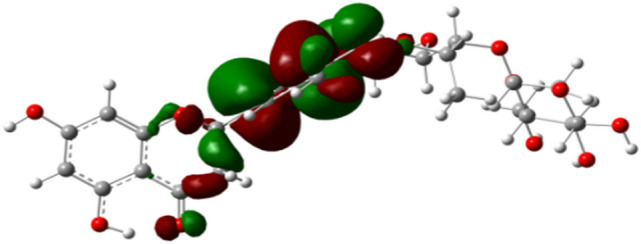
HOMO distribution map of the frontier orbital of the new flavonoid. Red color represents the positive part of the molecular orbital, while the green color represents the negative part.
The three flavonoid compounds have the same substituent at the 4′ position and different 3′ substituents, so the hydrogen-donating energy of the 3′-position functional group was calculated (Fig. 11). Based on the optimized molecular structures, the comparative analysis of enthalpy of hydrogen extraction reaction was also conducted. The calculation results of the hydrogen extraction enthalpy change of the substituent at the 3′ carbon position of the B ring are as follows: quercetin (22.5 kcal/mol) < hesperetin-5′-O-β-rhamnoglucoside (43.1 kcal/mol) < hesperetin-7-glucuronide (44.2 kcal/mol). The results show that the ortho-hydroxyl group of B ring has the strongest activity, mainly because it can carry out the second continuous scavenging reaction of free radicals37,38. Therefore, the theoretical prediction results are consistent with the experimental results, showing that DFT method can provide theoretical guidance for the screening of natural flavonoids antioxidants.
Figure 11.
Comparison of dehydrogenation barriers for three flavonoid compounds with 3′ ortho substituents of the ring B.
Conclusion
In conclusion, seven major flavonoids were extracted and isolated from the whole herb of dandelion Taraxacum mongolicum Hand.-Mazz. by optimized extraction protocol. Hesperetin-5′-O-β-rhamnoglucoside is a new type of flavonoid which was for the first time discovered in this work. The antioxidant activities against DPPH were evaluated and compared. In general, flavonoid has strong activity of scavenging free radicals. The mechanism of scavenging DPPH in vitro is that the substituents on the ring of flavonoids, such as hydroxyl and methoxy, react with free radicals. The molecular orbital energy levels of the flavonoid compounds with stronger antioxidant activity and the hydrogen extraction enthalpy of B ring substituents were reconfirmed by DFT calculation. The theoretical results are consistent with the experimental results, confirming that hesperetin-5′-O-β-rhamnoglucoside has stronger antioxidant activity mainly due to the combined effect of different substituents in B ring, as well as the enhanced hydrogen supply ability. Because these compounds are extracted from natural and edible herbal plant, and they are safe to use as antioxidants in food and cosmetic industries, therefore, this work has not only revealed new flavonoid compounds in dandelion, but also may suggest a new source of potential pharmacological nutrients.
Methods
Materials
Dandelion (Taraxacum mongolicum Hand.-Mazz) samples were picked from Wulanchabu City, Inner Mongolia. The species was identified by Yuan Ke Yan (inspector of Hohhot Food and Drug Inspection and Testing Center). The experimental material was the whole crushed dandelion including leaf, stem and root. Other chemicals were purchased, which include: rutin standard (HPLC purity ≥ 98% Shanghai McLean Biochemical Technology Co., Ltd.), absolute ethanol (AR Sinopharm), acetic acid (AR Sinopharm), polyamide resin (14–30 mesh Sinopharm), acetone (AR Xilong), methanol (AR Xilong), DMSO-d6 (purity > 99.9%, Shanghai Aladdin Biochemical Technology Co., Ltd.).
Extraction and isolation
In this experiment, the total flavones of dandelion were extracted by ethanol hot extraction method. The crushed 1 kg dried dandelion was investigated on the basis of ethanol concentration of 60%, extraction time of 30 min, liquid material ratio of 20:1 (mL: g), and extraction temperature of 50 °C. To optimize the dandelion flavonoid extraction, firstly, the single-factor experiments were conducted, wich change of extraction time (30, 40, 50, 60 and 70 min), extraction temperature (40, 50, 60 and 80 °C), and/or the ratio of liquid to material (20, 30, 40, 50 and 60:1 (v/w) mL/g) and ethanol concentration (40%, 50%, 60%, 70%, and 80% (v/w)). One factor was changed while the others were held constant in each experiment. Box–Behnken design (BBD) was employed to determine the best combination of different variables to maximize the flavonoid extraction based on the single-factor experimental results. The proper range for the extraction time (A) and the ratio of liquid to material were selected (B), extraction temperature (C) were determined, and then the response surface methodology was utilized to design the experimental conditions. The independent variables and their levels are given in Table 3. On the basis of the BBD data, a quadratic polynomial model was fitted to correlate the relationship between the independent variables and the response values to predict the optimized conditions.
Table 3.
Factors adopted in the BBD experiment.
| Level | Factor | ||
|---|---|---|---|
| A Extraction (time/min) | B Liquid-to-material ratio (mL/g) | C Extraction (temperature/℃) | |
| − 1 | 30 | 30:1 | 50 |
| 0 | 50 | 50:1 | 70 |
| 1 | 70 | 70:1 | 80 |
Determination of total flavonoids in dandelion
Total flavonoids content was determined following the previously described method of de la Rosa39. 1 mL of each sample (250 µg/mL dissolved in methanol) was added with 0.3 mL of sodium nitrite (5%, w/v) and aluminum nitrate (10%,w/v), shaken well, and allowed to stand for 5 min. Then, 4 mL sodium hydroxide (4%, w/v) was added without direct exposure to light and the resulting solution was allowed to stand for 30 min. The sample solution was evaluated using UV–Vis micro plate reader and the absorbance at 510 nm. After measuring the absorbance of the extract with the same method, the mass concentration of total flavonoids was calculated according to the regression equation obtained39: Total flavonoids yield (%) = C × V × N/M × 100%, where C is the mass concentration of total flavonoids in dandelion extract, mg/mL; V is the volume of dandelion extract, mL; N is the dilution ratio; M is the mass of dry dandelion powder, mg). Total flavonoids content was presented as catechin equivalents per gram of each sample.
Isolation and purification of dandelion flavonoids
After being activated with polyamide macroporous resin (bottom) + AB-8 macroporous resin (top), the sample solution was put into a glass separation column for initial separation. 42.7 g of crude extract was divided into three parts on average, eluted with 4.2 L of 70% methanol, acetone and 60% ethanol (volume ratio: 300 mL: 1 g) respectively. Every 500 mL of eluent was collected on Shimadzu LC-16P chromatographic column. YMC Pack ODS-A chromatographic column was used, and SPD-20A was used as the detector. The mobile phase was a binary system, phase A was water containing 0.1% formic acid, and phase B was acetonitrile. In water containing 0.1% formic acid, the gradient elution procedure was applied with the parameters set as: 0–2 min, 20% B; 2–7 min, 60% B; 7–10 min, 75% B; 10–14 min, 35% B; 15–17 min, 20% B.
Identification of extracted compounds
Different flavonoid compounds were analyzed by AB Triple TOFTM 5600 + LC–MS/MS (SCIEX, ShangHai, China) which was enabled with ultra-fast scanning speed and high mass spectrometry resolution and quantitative sensitivity, ensuring that the system can obtain high accuracy mass spectrometry data and quantitative detection limits. The separation of flavnoid substances in liquid chromatography was performed using C18 (100 mm × 4.6 mm, 5 µm particle size) reverse-phase column with the column temperature of 25 ℃. The mobile phase consists of 0.1% formic acid in water (A) and 100% acetonitrile (B) and the flow rate was 0.3 mL/min. The gradient settings for the elution program were as follows: 0–1 min, 95%A; 1–20 min, 95–70% A;20–30 min, 70–10% A; 30–35 min, 10% A; 35–36 min, 10–95%A; 36–40 min, 95%A. The injection volume was 10 µL (concentration unknown). The mass spectrum was obtained over heated electrospray ionization source in negative-ion modes. The key parameters were as follows: the spray voltage was + 3.8 and − 2.8 kV and sheath gas flow rate was 35 arbitrary units (arb unit); auxiliary-gas flow rate was 10 arb unit; capillary temperature was 325 °C with the auxiliary-gas-heater temperature was 350 °C. The scan range was from m/z 100 to 100,000, which covers the flavonoid molecular weight. Data acquisition and processing were carried out with Mass Frontier 7.0 and software Xcalibur 4.1 (Waltham, MA, Thermo Scientific), respectively. For the NMR analysis, the spectra were obtained using Bruker AV-500 spectrometers (500 MHz for 1H NMR and 125 MHz for 13C NMR) (Bruker, Switzerland). In addition, ultraviolet–visible (UV–Vis) spectroscopy was also performed on Shimadzu UV-2550 UV–Vis spectrophotometer (200–800 nm) for the compound analysis.
Assessment of antioxidant capacity
For the antioxidant assay, the compounds were tested against the standard oxidant DPPH. 25 mg DPPH was dissolved in 100 mL of absolute ethanol to obtain a stock solution, and a series of extract sample solutions of different concentrations (0, 2, 5, 10, 15, 20, 30, 40, 50 mg/L) were prepared. For the antioxidant activity measurement, the absorbance value at 517 nm was measured after reaction, and all experiment was repeated for three times. The DPPH radical scavenging capacity was calculated as follows: DPPH· scavenging activity (%) = [1 − (As − Ab)/Ad] × 100%, where Ad is the absorbance value of 4 mL 50 mg/L DPPH, As is the solution absorbance value of 4 mL 50 mg/L DPPH ethanol solution plus 1 mL sample, and Ab is the absorbance value of 4 mL absolute ethanol solution plus 1 mL sample solution. The evaluation and comparison of free radical scavenging capacity of antioxidants is based on IC50 value, which corresponds to the antioxidant solution concentration when DPPH· radical scavenging rate is 50%40.
Theoretical calculations
Calculations were performed to assist the understanding and confirmation of the experimental results including structures, antioxidant activities and spectra. All the calculations were carried out using Gaussian 09 package. The calculations in this work were performed by applying the functionals B3LYP with 6-311G++(d, p) basis set. The calculations gave rise to the energy levels and energy ranges of the highest occupied orbital (HOMO) and the lowest empty orbital (LUMO) of the products with the top three oxidation resistance, as well as the hydrogen extraction enthalpy of B ring substituents41. In addition, the NMR 1H and 13C spectra were calculated under the condition of Opt + Freq/GIAO42.
Plants materials
The study complies in accordance with relevant guidelines and regulations.
Supplementary Information
Acknowledgements
This work was supported by the National Natural Science Foundation of China (grant No. 11635013) and the Research Integration Program of Hefei Institutes of Physical Science, Chinese Academy of Sciences.
Author contributions
R.W.: conceptualization; data curation; formal analysis; investigation; methodology; writing—original draft. W.L., C.F., X.Z., C.L.: investigation; methodology; Q.H.: conceptualization; formal analysis; funding acquisition; investigation; methodology; project administration; supervision; writing—original draft; writing—review and editing.
Funding
National Natural Science Foundation of China, grant No: 11635013.
Data availability
All data generated or analysed during the current study available from the corresponding author on reasonable request.
Competing interests
The authors declare no competing interests.
Footnotes
Publisher's note
Springer Nature remains neutral with regard to jurisdictional claims in published maps and institutional affiliations.
Supplementary Information
The online version contains supplementary material available at 10.1038/s41598-023-28775-x.
References
- 1.Hu C, Kitts DD. Luteolin and luteolin-7-O-glucoside from dandelion flower suppress iNOS and COX-2 in RAW264.7 cells. Mol. Cell Biochem. 2004;265:107–113. doi: 10.1023/B:MCBI.0000044364.73144.fe. [DOI] [PubMed] [Google Scholar]
- 2.Zeng LZ, Huo SM. Discussion about the chemical names of the steroid drugs in Chinese pharmacopoeia 2005 edition (volume II) Chin. Drug Stand. 2007;04:10–12. doi: 10.19778/j.chp.2007.04.009. [DOI] [Google Scholar]
- 3.González-Castejón M, Visioli F, Rodriguez-Casado A. Diverse biological activities of dandelion. Nutr. Rev. 2012;70:534–547. doi: 10.1111/j.1753-4887,2012.00509.x. [DOI] [PubMed] [Google Scholar]
- 4.Jin SL, Yin YG. In vivo antioxidant activity of total flavonoids from indocalamus leaves in aging mice caused by d-galactose. Food Chem. Toxicol. 2012;50:3814–3818. doi: 10.1016/j.fct.2012.07.046. [DOI] [PubMed] [Google Scholar]
- 5.Astafieva AA, et al. Novel proline-hydroxyproline glycopeptides from the dandelion (Taraxacum officinale Wigg.) flowers: de novo sequencing and biological activity. Plant Sci. 2015;238:323–329. doi: 10.1016/j.plantsci.2015.07.002. [DOI] [PubMed] [Google Scholar]
- 6.Jedrejek D, Kontek B, Lis B, Stochmal A, Olas B. Evaluation of antioxidant activity of phenolic fractions from the leaves and petals of dandelion in human plasma treated with H2O2 and H2O2/Fe. Chem. Biol. Interact. 2017;262:29–37. doi: 10.1016/j.cbi.2016.12.003. [DOI] [PubMed] [Google Scholar]
- 7.Yanghee Y, et al. In vitro and in vivo hepatoprotective effects of the aqueous extract from Taraxacum officinale (dandelion) root against alcohol-induced oxidative stress. Food Chem. Toxicol. 2010;48:1632–1637. doi: 10.1016/j.fct.2010.03.037. [DOI] [PubMed] [Google Scholar]
- 8.Yuldashev MP, Muminova BA, Drenin AA, et al. Flavonoids from the aerial part of Vicia subvillosa. Chem. Nat. Compd. 2007;43:34–36. doi: 10.1007/s10600-007-0058-5. [DOI] [Google Scholar]
- 9.Shi SY, Zhou CX, Xu Y, Tao QF, Zhao Y. Studies on chemical constituents from herbs of Taraxacum mongolicum. Chin. J. Tradit. Chin. Med. 2008;33:1147–1157. [PubMed] [Google Scholar]
- 10.Yan ZA, Yfh A, Wei LA, et al. Updates and advances on pharmacological properties of Taraxacum mongolicum Hand.-Mazz and its potential applications. Food Chem. 2022;373:131380. doi: 10.1016/j.foodchem.2021.131380. [DOI] [PubMed] [Google Scholar]
- 11.Wen L, et al. Identification of a flavonoid C-glycoside as potent antioxidant. Free Radic. Biol. Med. 2017;110:92–101. doi: 10.1016/j.freeradbiomed.2017.05.027. [DOI] [PubMed] [Google Scholar]
- 12.Kumar S, Pandey AK. Chemistry and biological activities of flavonoids: An overview. Sci. World J. 2013;2013:162750. doi: 10.1155/2013/162750. [DOI] [PMC free article] [PubMed] [Google Scholar]
- 13.Park CM, Song YS. Luteolin and luteolin-7-O-glucoside inhibit lipopolysaccharide-induced inflammatory responses through modulation of NF-kappaB/AP-1/PI3K-Akt signaling cascades in RAW 264.7 cells. Nutr. Res. Pract. 2013;7:423–429. doi: 10.4162/nrp.2013.7.6.423. [DOI] [PMC free article] [PubMed] [Google Scholar]
- 14.Lis B, Jedrejek D, Moldoch J, Stochmal A, Olas B. The anti-oxidative and hemostasis-related multifunctionality of l-chicoric acid, the main component of dandelion: An in vitro study of its cellular safety, antioxidant and anti-platelet properties, and effect on coagulation. J. Funct. Foods. 2019 doi: 10.1016/j.jff.2019.103524. [DOI] [Google Scholar]
- 15.Xu XM, Dong WB, Lu J. Research progress in preparation technology of total flavones of dandelion. Food Eng. 2018;02:61–64. [Google Scholar]
- 16.Jing NL, Yuan HZ, Yong HH, Shan XH, Peng F. Improving the color stability and antioxidation activity of blueberry anthocyanins by enzymatic acylation with p-coumaric acid and caffeic acid. LWT. 2020;130:109673. doi: 10.1016/j.lwt.2020.109673. [DOI] [Google Scholar]
- 17.Ameha S, Kaleab A, Fathy KF. Structure–radical scavenging activity relationships of flavonoids. Phytochemistry. 2006;67:2058–2070. doi: 10.1016/j.phytochem.2006.07.002. [DOI] [PubMed] [Google Scholar]
- 18.Nguelefack TB, Mbakam FH, Tapondjou LA, Watcho P, Park HJ. A dimeric triterpenoid glycoside and flavonoid glycosides with free radical-scavenging activity isolated from Rubus rigidus var. camerunensis. Arch. Pharm. Res. 2011;34:543–550. doi: 10.1007/s12272-011-0404-9. [DOI] [PubMed] [Google Scholar]
- 19.Shen N, Wang T, Gan Q, Liu S, Jin B. Plant flavonoids: Classification, distribution, biosynthesis, and antioxidant activity. Food Chem. 2022;30:132531. doi: 10.1016/j.foodchem.2022.132531. [DOI] [PubMed] [Google Scholar]
- 20.Toshiya M, Jun A, Aya F, Satoshi Y, Yoshiaki S. Antioxidation reaction mechanism studies of phenolic lignans, identification of antioxidation products of secoisolariciresinol from lipid oxidation. Food Chem. 2010;123:442–450. doi: 10.1016/j.foodchem.2010.04.065. [DOI] [Google Scholar]
- 21.Catherine A, Rice E, Nicholas J, Miller Structure-antioxidant activity relationships of flavonoids and phenolic acids. Free Radic. Biol. Med. 1996;20:933–956. doi: 10.1016/0891-5849(95)02227-9. [DOI] [PubMed] [Google Scholar]
- 22.Chun LT, Xin L, Yu C, Ru XW, Ming CL. Investigation of the anti-inflammatory and antioxidant activities of luteolin, kaempferol, apigenin and quercetin. S. Afr. J. Bot. 2021;137:257–264. doi: 10.1016/j.sajb.2020.10.022. [DOI] [Google Scholar]
- 23.Gorgannezhad L, Dehghan G, Ebrahimipour SY, Naseri A, NazhadDolatabadi JE. Complex of manganese (II) with curcumin: Spectroscopic characterization, DFT study, model-based analysis and antiradical activity. J. Mol. Struct. 2016;1109:139–145. doi: 10.1016/j.molstruc.2015.12.051. [DOI] [Google Scholar]
- 24.Horton W, Peerannawar S, Török B, Török M. Theoretical and experimental analysis of the antioxidant features of substituted phenol and aniline model compounds. Struct. Chem. 2018;30:23–35. doi: 10.1007/s11224-018-1183-4. [DOI] [Google Scholar]
- 25.Cai W, Chen Y, Xie L, Zhang H, Hou C, et al. Characterization and density functional theory study of the antioxidant activity of quercetin and its sugar-containing analogues. Eur. Food Res. Technol. 2013;238:121–128. doi: 10.1007/s00217-013-2091-x. [DOI] [Google Scholar]
- 26.Abuelizz HA, Taie HAA, et al. Investigation of 4-hydrazinobenzoic acid derivatives for their antioxidant activity: In vitro screening and DFT study. ACS Omega. 2021;6:31993–32004. doi: 10.1021/acsomega.1c04772. [DOI] [PMC free article] [PubMed] [Google Scholar]
- 27.Borges RS, Costa FM, Pereira TL, et al. N-acetyl-cysteine increases chemical stability of hydroquinone in pharmaceutical formulations: A theoretical and experimental approach. J. Braz. Chem. Soc. 2017;29:609–614. doi: 10.21577/0103-5053.20170174. [DOI] [Google Scholar]
- 28.Wolfe KL, Liu RH. Structure–activity relationships of flavonoids in the cellular antioxidant activity assay. J. Agric. Food Chem. 2010;56:8404–8411. doi: 10.1021/jf8013074. [DOI] [PubMed] [Google Scholar]
- 29.Zheng YZ, Deng G, Guo R, Chen DF, Fu ZM. DFT studies on the antioxidant activity of naringenin and its derivatives: Effects of the substituents at C3. Int. J. Mol. Sci. 2013;20:1450. doi: 10.3390/ijms20061450. [DOI] [PMC free article] [PubMed] [Google Scholar]
- 30.Maltarollo VG, Sannomiya M, Honório KM. Molecular modeling studies on molecular properties of mutagenic flavonoids. J. Comp. Theo. Nano. 2013;10:1385–1390. doi: 10.1166/jctn.2013.2859. [DOI] [Google Scholar]
- 31.Arumugam P, Samikannu PF, Rajaram R. Theoretical investigation of inclusion complexes of 3-hydroxyflavone and quercetin as guests with native and modified β-cyclodextrins as hosts. Polycyclic Aromat. Compd. 2022;1040–6638:2021. doi: 10.1080/10406638.2021.2009526. [DOI] [Google Scholar]
- 32.Zhang W, Xu M, Yu C, Zhang G, Tang X. Simultaneous determination of vitexin-4″-O-glucoside, vitexin-2″-O-rhamnoside, rutin and vitexin from hawthorn leaves flavonoids in rat plasma by UPLC-ESI-MS/MS. J. Chromatogr. B Analyt. Technol. Biomed. Life Sci. 2010;878:1837–1844. doi: 10.1016/j.jchromb.2010.05.023. [DOI] [PubMed] [Google Scholar]
- 33.Zhou B, Zheng L, Hu D. DFT study on antioxidant activity of natural phenolic compounds phloretin and phloretin. J. Mol. Sci. 2018;34:517–520. doi: 10.13563/j.cnki.jmolsci.2018.06.013. [DOI] [Google Scholar]
- 34.Liu J, Zhang Z, Yang L, Fan Y, Liu Y. Molecular structure and spectral characteristics of hyperoside and analysis of its molecular imprinting adsorption properties based on density functional theory. J. Mol. Graph. Model. 2019;88:228–236. doi: 10.1016/j.jmgm.2019.01.005. [DOI] [PubMed] [Google Scholar]
- 35.Vedpal JU, Wadhwani A, Dhanabal SP. Isolation and characterization of flavonoids from the roots of medicinal plant Tadehagi triquetrum (L.) H. Ohashi. Nat. Prod. Res. 2020;34:1913–1918. doi: 10.1080/14786419.2018.1561679. [DOI] [PubMed] [Google Scholar]
- 36.Eric J, Liena R, et al. Quantitative structure-activity relationship analysis of phenolic antioxidants. Free Radic. Biol. Med. 1999;26:285–294. doi: 10.1016/S0891-5849(98)00190-7. [DOI] [PubMed] [Google Scholar]
- 37.Hu DB, Li DL, Li M, Wu XX. Density functional theory investigation on antioxidant activity of five flavonoids from Hebei Xiangju. Chin. J. Tradit. Med. 2016;42:719–724. doi: 10.19540/j.cnki.cjcmm.20161222.072. [DOI] [PubMed] [Google Scholar]
- 38.Krishna K, Revathia R, Sathyab S. Molecular structure, spectroscopic (FT-IR, FT-Raman, C and H NMR) analysis, HOMO-LUMO energies, mulliken, MEP and thermal properties of new chalcone derivative by DFT calculation131. Mater. Today Proc. 2019;8:37–46. doi: 10.1016/j.matpr.2019.02.078. [DOI] [Google Scholar]
- 39.De LR, Alma A, Vazquez-Flores EA, Joaquín RG, et al. Content of major classes of polyphenolic compounds, antioxidant, antiproliferative, and cell protective activity of pecan crude extracts and their fractions. J. Funct. Foods. 2014;7:219–228. doi: 10.1016/j.jff.2014.02.008.16. [DOI] [Google Scholar]
- 40.Pan G, Ruijie L, Qing ZJ, Xing GW. Comparative study of chemical compositions and antioxidant capacities of oils obtained from two species of walnut: Juglans regia and Juglans sigillata. Food Chem. 2018;279:279–287. doi: 10.1016/j.foodchem.2018.12.016. [DOI] [PubMed] [Google Scholar]
- 41.Wen YL, Lin YC, Ying YH, Ling F, Yue FB. Antioxidation and active constituents analysis of flower residue of Rosa damascena. Chin. Herb. Med. 2020;12:336–341. doi: 10.1016/j.chmed.2020.05.005. [DOI] [PMC free article] [PubMed] [Google Scholar]
- 42.Bella G, Rotondo A. Theoretical prediction of (13)C NMR spectrum of mixed triglycerides by mean of GIAO calculations to improve vegetable oils analysis. Chem. Phys. Lipids. 2020;232:104973. doi: 10.1016/j.chemphyslip.2020.104973. [DOI] [PubMed] [Google Scholar]
Associated Data
This section collects any data citations, data availability statements, or supplementary materials included in this article.
Supplementary Materials
Data Availability Statement
All data generated or analysed during the current study available from the corresponding author on reasonable request.




